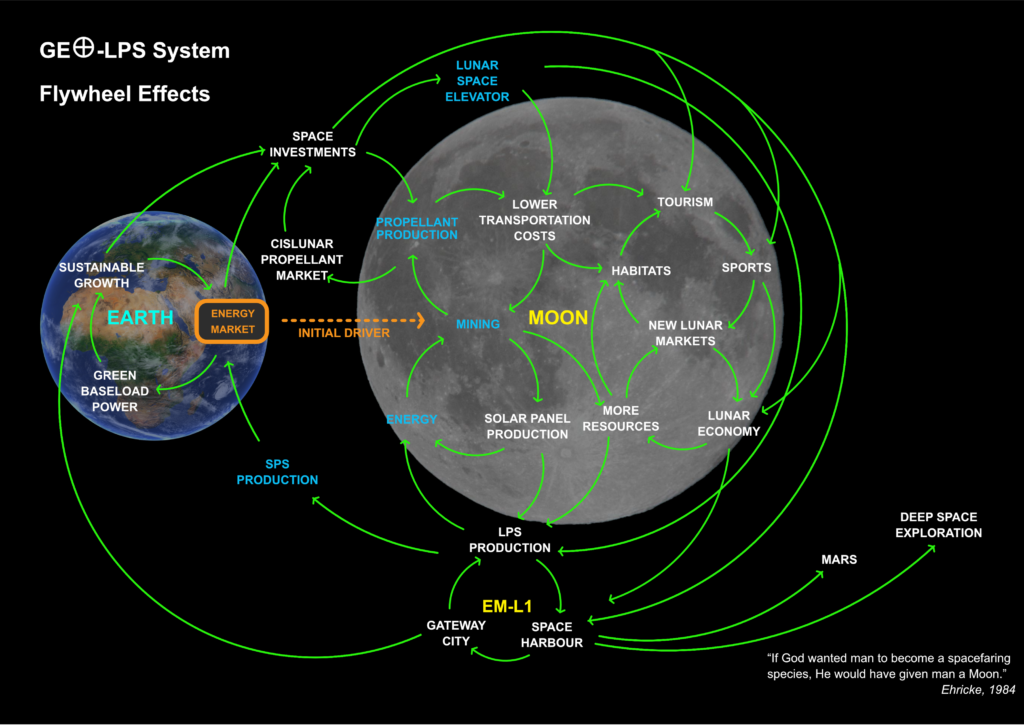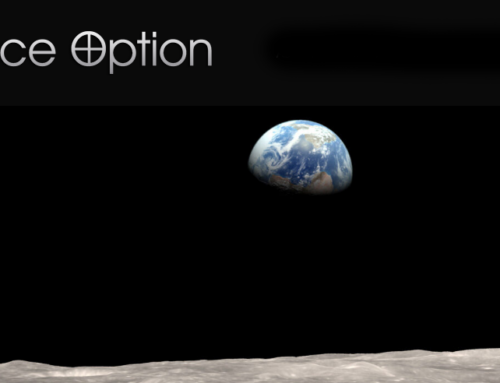The Greater Earth Lunar Power Station (GE⊕-LPS)
Astrostrom GmbH has been investigating the feasibility of a “Greater Earth Lunar Power Station” (GE⊕-LPS) (*) manufactured on the Moon and assembled at the Earth-Moon Lagrange Point 1 to provide power from lunar orbit to operations on the surface of the Moon. Once the initial station is in operation, the production facilities on the lunar surface could be then used to produce additional Solar Power Satellites (SPS) to be shipped into Earth orbits to deliver clean baseload solar energy to Earth. This ‘Space Energy Option’ would contribute to a massive reduction of the use of fossil fuels for energy production on the way towards meeting international climate and energy targets. The GE⊕-LPS is a crewed facility in lunar orbit that will be constructed primarily from lunar materials. Shown to be both feasible and scalable, manufacturing future SPS components from lunar materials and transporting these to geostationary orbit (GEO), would be a means to avoid the need to launch hundreds or thousands of massive SPSs from the surface of the Earth in order to supply environmentally benign, baseload electricity to Earth. The construction of GE⊕-LPS with lunar materials requires developing facilities on the Moon for automated mining and manufacturing processes. The materials required for GE⊕-LPS structure include cast basalt and basalt fibre for the structural elements. The solar panels would be manufactured from iron pyrite monograin-layer solar cells produced on the Moon, whereas metals such as iron and aluminium will serve for the electrical connections.
This approach to realizing Space-Based Solar Power (SBSP) could reduce the amount of mass for a SPS launched from Earth by 80% or more as well as reducing costs and the related CO2 emissions. The establishment of industrial-scale, robotic beneficiation and processing plants will provide access to several other materials, which may become valuable to other users in the cislunar region. In addition to small amounts of Helium-3, a vast amount of oxygen will be produced as a by-product which can be used in life support systems and as rocket propellant, thereby creating additional business cases for new cislunar enterprises. The Astrostrom study also outlined a business case based on the terrestrial energy market and the demand for clean energy on Earth. BloombergNEF and other organizations have estimated that the European energy transition will be a 5 trillion Euro or more investment opportunity. Based on the study, just 2% of the cost of the European energy transition – € 99 billion or less – would be sufficient to install the infrastructure needed to begin manufacturing SPS components on the Moon which could soon be repaid from SBSP electricity sales to Earth.
(*) Note: The ‘⊕’ symbol is an ancient European symbol for planet Earth: it is used here to mean “Greater Earth”, a region defined by the Earth’s gravitational field, which includes the Moon.
Clean Energy from Space
The study was selected from the European Space Agency’s (ESA) open call “Clean Energy from Space” [1] which sought novel ideas related to Space-Based Solar Power (SBSP) systems. During the study, ESA announced the SOLARIS programme [2] to explore the feasibility and potential of SBSP to provide clean energy to Earth, for which funding was approved by the ESA Council at the Ministerial Level in November 2022. Astrostrom was asked by ESA to produce a promotional video introducing the SOLARIS initiative that was shown during this meeting [3]. Now ESA has since announced the first results of the study [4].
The GE⊕-LPS is a crewed facility in lunar orbit that will be constructed primarily from lunar materials. Shown to be both feasible and scalable, manufacturing future SPS components from lunar materials and transporting these to geostationary orbit (GEO), would be a means to avoid the need to launch hundreds or thousands of massive SPSs from the surface of the Earth in order to supply environmentally benign, baseload electricity to Earth. The GE⊕-LPS is a concept that advances lunar development with the ultimate aim to address the terrestrial energy and climate crises.
The construction of GE⊕-LPS with lunar materials requires developing facilities on the Moon for automated mining and manufacturing processes. The materials required for GE⊕-LPS include cast basalt and basalt fibre for the structural elements. Silicon, ilmenite and especially pyrite are considered for semiconductors and photovoltaics, whereas metals such as iron and aluminium will serve for the electrical connections. The establishment of industrial-scale, robotic beneficiation and processing plants will provide access to several other materials, which may become valuable to other users in the cislunar region. In addition to small amounts of Helium-3, a vast amount of oxygen will be produced as a by-product which can be used in life support systems and as rocket propellant, thereby creating additional business cases for new cislunar enterprises.
Video: Greater Earth Energy Synergies is an overview of the GE⊕-LPS study.
Inspired by the Butterfly
Taking inspiration from the butterfly, GE⊕-LPS features V-shaped solar panels with integrated antennas, deployed in a helix configuration extending more than a square kilometre end-to-end. The initial design would yield 23 megawatts of continuous electrical power for lunar surface operations. Later designs are targeted to reach gigawatt scale power levels. The solar panels would be manufactured from an iron pyrite monograin-layer solar cells produced on the Moon. Astrostrom’s approach to realizing SBSP could reduce the amount of mass for a SPS launched from Earth by 80% or more as well as reducing costs and the related CO2 emissions. The ‘butterfly’ – a living symbol of metamorphosis – can be seen as signalling humanity’s transformation from the fossil fuel age into the space energy age.
Dr. Sanjay Vijendran, overseeing ESA’s SOLARIS program explains:
“Launching large numbers of gigawatt-scale solar power satellites into orbit from the surface of the Earth would run into the problem of a lack of launch capacity as well as potentially significant atmospheric pollution. But once a concept like GE⊕-LPS has proven the component manufacturing processes and assembly concept of a solar power satellite in lunar orbit, it can then be scaled up to produce further solar power satellites from lunar resources to serve Earth. This would also create many other benefits in addition to providing sufficient clean energy for Earth, including the development of a cislunar transportation system, mining, processing, and manufacturing facilities on the Moon and in orbit resulting in a two-planet economy and the birth of a spacefaring civilisation.”
The Business Case
The Astrostrom study also outlined a business case based on the energy market and the demand for clean energy on Earth. BloombergNEF and other organizations have estimated that the European energy transition will be a 5 trillion Euro or more investment opportunity [7]. Based on the study, just 2% of the cost of the European energy transition – € 99 billion or less – would be necessary to install the infrastructure needed to begin manufacturing SPS components on the Moon. It proposes a multi-national stakeholder organisation called the ‘Greater Earth Energy Organisation’ for this purpose. Recent developments including lowered launch costs, automation, robotics, and materials technology have made the start of a lunar economy a viable investment opportunity.

The international study team consisted of:
Arthur Woods, Astrostrom GmbH, Switzerland – Team Leader, Project Manager, Cultural Analyst
astrostrom.ch
Andreas Vogler, Andreas Vogler Studio, Germany – Architect ETH and System Designer
andreasvogler.com
Dr. Patrick Collins, Japan – SBSP, Space Tourism and Economics Expert
www.spacefuture.com
Dmitrijis Gasperovics, Latvia – Visualizer and Animator
References:
- ESA Supported Technology Developments:
https://www.esa.int/Enabling_Support/Space_Engineering_Technology/SOLARIS/ESA-supported_technology_developments - ESA Solaris:
https://www.esa.int/Enabling_Support/Space_Engineering_Technology/SOLARIS - ESA Solaris video on YouTube.
https://www.youtube.com/watch?v=8ScTbb-43A4 - ESA: Lunar Solar Power Satellite
https://www.esa.int/ESA_Multimedia/Images/2023/07/Lunar_solar_power_satellite - ESA: Announcement of study on LinkedIn: https://lkdin.io/4ANI
- ESA: Nebula Archive: https://nebula.esa.int/content/ge%E2%8A%95-lunar-power-station
- BloombergNEF: Europe’s Path to Clean Energy: A $5.3 Trillion Investment Opportunity. (Published: April 13, 2022)
https://about.bnef.com/blog/europes-path-to-clean-energy-a-5-3-trillion-investment-opportunity/
Hi-Res images and videos are available and Zoom interviews are invited.
Download the Executive Summary: PDF (34 pages)
Download the Final Report: PDF (269 pages)
Pressemitteiling: 24.07.2023 als PDF herunterladen
Videos produced during the study:
Here to Stay
This video shows our vision of arriving on the Moon, deploying a mobile solar power system, commencing mining operations and protecting the habitat from radiation.
Mining the Moon
This video shows the Beneficiation, Processing, Fabrication and Transportation of the components for the Greater Earth Lunar Power Station
Lunar Space Elevator
The video shoes the main elöement of the cislunar transporation system.
Up and Down the Cislunar Transportation System
This video shows Lunar Space Elevator Base Station, the Lunar Landing Gantry and the Robotic Assembly of the GE⊕-LPS in Lunar Orbit






